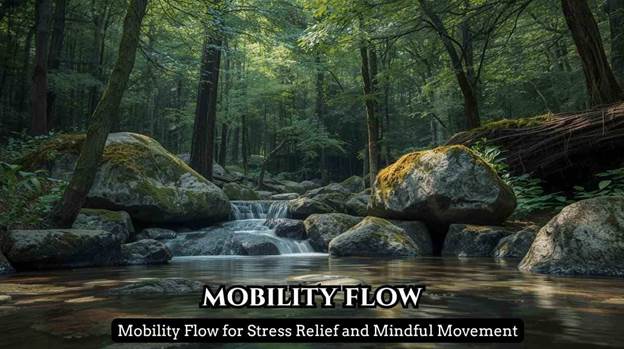Understanding Mobility Flow and Its Connection to Mindfulness
A mobility flow is more than just a sequence of physical movements it’s a mindful practice that synchronizes breath, body, and awareness. Unlike traditional stretching or workout routines, mobility flow encourages fluid, intentional motion that promotes both physical flexibility and mental calm. Through mindful movement, it becomes a tool for relieving tension, enhancing focus, and restoring balance between the body and mind.
Table of Contents
In today’s fast-paced lifestyle, where stress often feels unavoidable, mobility flow offers a holistic approach to wellness. It blends the strength of fitness with the serenity of meditation, helping people reconnect with their natural rhythm. This article explores the meaning, history, benefits, and real-world impact of mobility flow, revealing how it can transform your daily well-being through mindful, stress-free movement.
What is Mobility Flow?
A mobility flow refers to a series of controlled, flowing movements that enhance joint flexibility, muscle coordination, and body awareness. Unlike static stretching, which isolates one muscle group, mobility flow links dynamic movements together similar to yoga or tai chi.
This practice focuses on improving joint mobility, posture, and overall movement efficiency while reducing stiffness. It also fosters mindfulness by encouraging practitioners to move with intention and focus on the sensations of their body. Through consistent practice, mobility flow enhances physical health and supports emotional stability by reducing stress and tension stored in the muscles.
The Origins and Evolution of Mobility Flow Practices
The concept of mobility flow has evolved from various movement disciplines, including yoga, martial arts, and functional fitness training. Ancient practices like Qi Gong and Tai Chi already embodied the idea of flowing, mindful movement, combining breath control with physical motion to balance the body’s energy.
The Importance of Mindful Movement in Mobility Flow
1. Enhancing Mind-Body Connection
At the heart of mobility flow lies mindfulness. Every transition between movements requires attention to breath and alignment. This process helps quiet mental noise and anchor the practitioner in the present moment.
2. Reducing Physical and Mental Stress
When performed with intention, mobility flow for stress relief activates the parasympathetic nervous system the body’s natural relaxation response. Gentle, rhythmic motion reduces cortisol levels and releases physical tension accumulated through prolonged sitting or emotional strain.
3. Building Sustainable Flexibility
Unlike intense workouts, mobility flow promotes flexibility without strain. The movements are designed to gradually open joints and muscles, improving range of motion while maintaining comfort and control.
Benefits of Mobility Flow for Stress Relief
Integrating mobility flow into your daily routine can provide numerous physical and psychological benefits.
•Stress Reduction: Focused breathing and smooth movements lower anxiety and calm the nervous system.
•Improved Posture: It counteracts the effects of long hours spent sitting or using digital devices.
•Enhanced Circulation: Continuous motion improves blood flow, delivering oxygen and nutrients to muscles.
•Injury Prevention: Regular practice strengthens connective tissues and supports joint health.
•Mental Clarity: The meditative rhythm of movement helps declutter thoughts and improve concentration.
The holistic benefits of mobility flow make it a powerful self-care ritual that supports both relaxation and resilience.
Challenges and Misconceptions About Mobility Flow
Despite its effectiveness, mobility flow is sometimes misunderstood as being only for advanced practitioners or athletes. In reality, it’s suitable for everyone, regardless of age or fitness level.
Common Challenges:
•Inconsistency: Many people start mobility flow routines but stop before seeing long-term results.
•Lack of Awareness: Without proper guidance, movements can become mechanical rather than mindful.
•Overemphasis on Performance: Some individuals treat mobility flow as another workout instead of a meditative experience.
By focusing on breath, slowing down, and releasing self-judgment, practitioners can overcome these challenges and truly experience the transformative power of mindful movement.

Real-world Applications of Mobility Flow
In the Workplace
Mobility flow sessions can be integrated into short breaks during office hours. Simple movements like shoulder rolls, spine waves, and deep breathing can relieve tension from extended computer use.
In Mental Health Therapy
Therapists now use mobility flow for stress relief as part of holistic treatment plans for anxiety and burnout. Movement-focused mindfulness has proven effective in reducing emotional fatigue.
In Fitness and Sports
Athletes use mobility flow to improve joint health and recovery. The continuous movement pattern reduces muscle stiffness and enhances performance without overtraining.
These examples show how mobility flow can fit into different lifestyles from corporate wellness to personal relaxation making it one of the most accessible forms of mindful exercise.
How to Start a Simple Mobility Flow Routine
If you’re new to mobility flow, start small. Dedicate 10–15 minutes daily to connect breath and motion.
Example beginner routine:
•Neck rolls and shoulder circles to release upper tension
•Spinal twists to improve flexibility
•Hip circles to enhance lower body mobility
•Gentle squats and forward bends for grounding
•Deep breathing to close the session and reset energy
The key is to move slowly, stay aware of sensations, and maintain a smooth rhythm. Over time, your mobility flow practice will evolve into a personal form of moving meditation.
Conclusion (90 words)
A mobility flow is more than just movement it’s mindfulness in motion. By linking breath, awareness, and gentle transitions, it helps release physical and mental stress while enhancing flexibility and focus. Practicing mobility flow regularly fosters resilience, inner calm, and emotional balance. Whether used for fitness, therapy, or relaxation, it offers a holistic path to well-being. Start integrating mindful movement into your day, breathe deeply, and allow mobility flow to guide you toward greater peace and vitality one intentional movement at a time.






One comment on “Mobility Flow for Stress Relief and Mindful Movement”